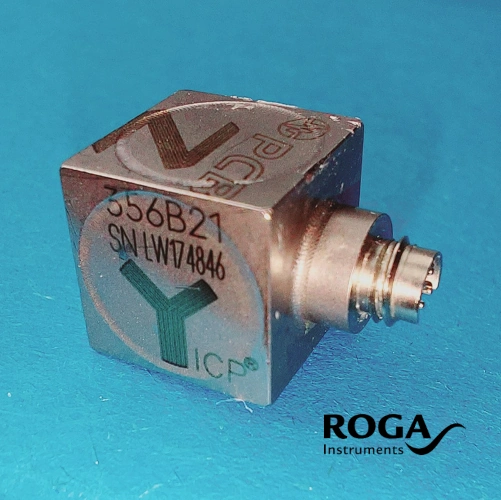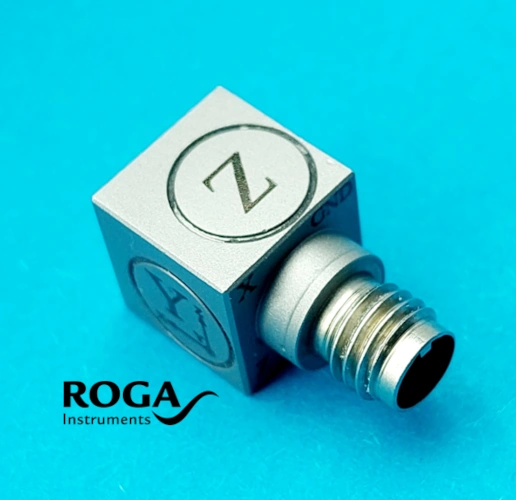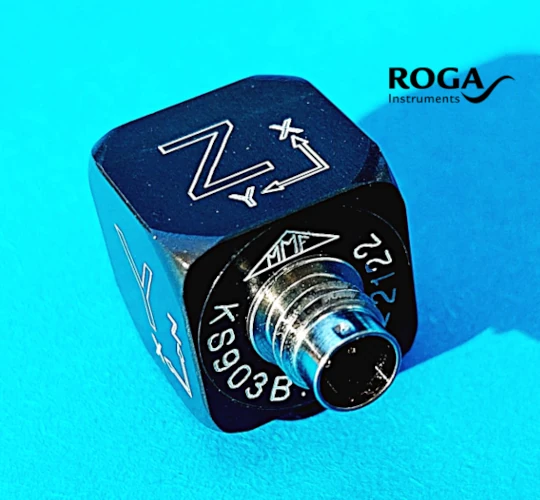PCB Triaxial Accelerometer - ICP® Triaxial Accelerometer - IEPE Triaxial Vibration Sensor
PCB Model 356B21

- Price: 980 €
2nd HAND TRIAXIAL ACCELEROMETER
- Triaxial ICP® accel.
- 10 mV/g
- 500 g
- 2 to 7 kHz,
- mini 4-pin conn.
- Scope of delivery:
- 356B21 Triaxial accelerometer
- Certificate of calibration
- Model 034K10 Cable 10FT Mini 4 Pin To (3) BNC (1)
- PCB 356B21 Datasheet
Vibration monitoring on rotating machines
RogaDAQ4 NVH-MON KIT
Areas of application
- Machine and plant engineering
- Production lines & manufacturing
- Pumps, motors, bearings & gearboxes
- POC Pilot projects for the introduction of predictive maintenance

- Price: 1520 €
141A10 – 10 mV/g
To use a triaxial accelerometer to measure vibration, you need to attach it to the surface of interest with a mounting fixture and connect it to a vibration analyzer or data logger.
You can then measure vibration levels in three axes – X, Y and Z – and analyze the data to identify patterns or irregularities.
Triaxial accelerometers are a useful tool for anyone involved in machine maintenance, structural inspection or vibration analysis, offering valuable insight into the health of the systems they monitor.
Features:
- Small dimensions
- Excellent phase response
- High resolution
- Low temperature coefficient
- Well suited for modal and structural analysis
- For sensitivity variants (10, 20, 50 and 100 mV/g)
Delivery with sensor cable 5 meter
- 141A10 Triaxial accelerometer
- Connection cable 1/4-28(4-Pin)/3-BNC (5 Meter)
- Certificate of calibration

- Price: 1780 €
KS903B10/01 – 10 mV/g
Features:
- Small dimensions
- Excellent phase response
High resolution - Low temperature coefficient
- Contains digital memory for sensor data (TEDS according to IEEE 1451.4; Template 25 m. DS2431)
- Well suited for modal and structural analysis
- Two sensitivity variants (10 and 100 mV/g)
Delivery with accessory case:KS903B10x/01:
- 091-CMR-B711-3: Cable for IEPE sensors; 3 m; 1/4″-28; 4-pin on Binder 711; mnl.; 120 °C; D2.1
- 034-B711f-BNC: Adapter Binder 711; 0.5 m; 4-pin to wbl.; 3 x BNC; mnl.; 80 °C
- 708: Rare earth holding magnet; M5; SW15; 120 °C
- 029: Adhesive insulating flange; M5; D15; >250 °C
- 003: Threaded screw; M5 x 8
Triaxial Seismic Accelerometer Set

- Price: 2778 €
KS48C-3 + 729 Tripod floor plate Set
KS48C Specifications
- High Sensitivity Accelerometer
- Suitable for seismic measurements and structural investigations at low frequencies
- Highly sensitive sensor system without internal amplification thus excellent resolution and lowest noise
- Particularly good sensitivity/ mass ratio
- IEPE voltage output
- Frequency response 0.07 Hz – 4000 Hz (-3dB)
- Sensitivity 1000 mV/g
- Residual noise wide band; <14 µg RMS (0,5 – 10000 Hz)
- Mass 165 grams
- Measuring range ± 6 g
- Robust design with M12 connector
- Protection grade IP67
- Scope of delivery:
- 230 Triaxial mounting cube; M8; □34
- 729 Tripod floor plate to DIN 45669-2
- 3 * KS48C High Sensitivity Accelerometer 1000 mV/g
®TRADEMARK
ICP is a registered trademark of PCB Piezotronics, Inc., DeltaTron is a registered trademark of Hottinger Brüel & Kjær A/S, ISOTRON is a registered trademark of ENDEVCO.
This document only describes the technical principles involved and inevitably mentions the registered trademarks of other manufacturers, which is not intended and will not harm the interests of trademark owners. The registered trademarks mentioned above belong to their respective owners.